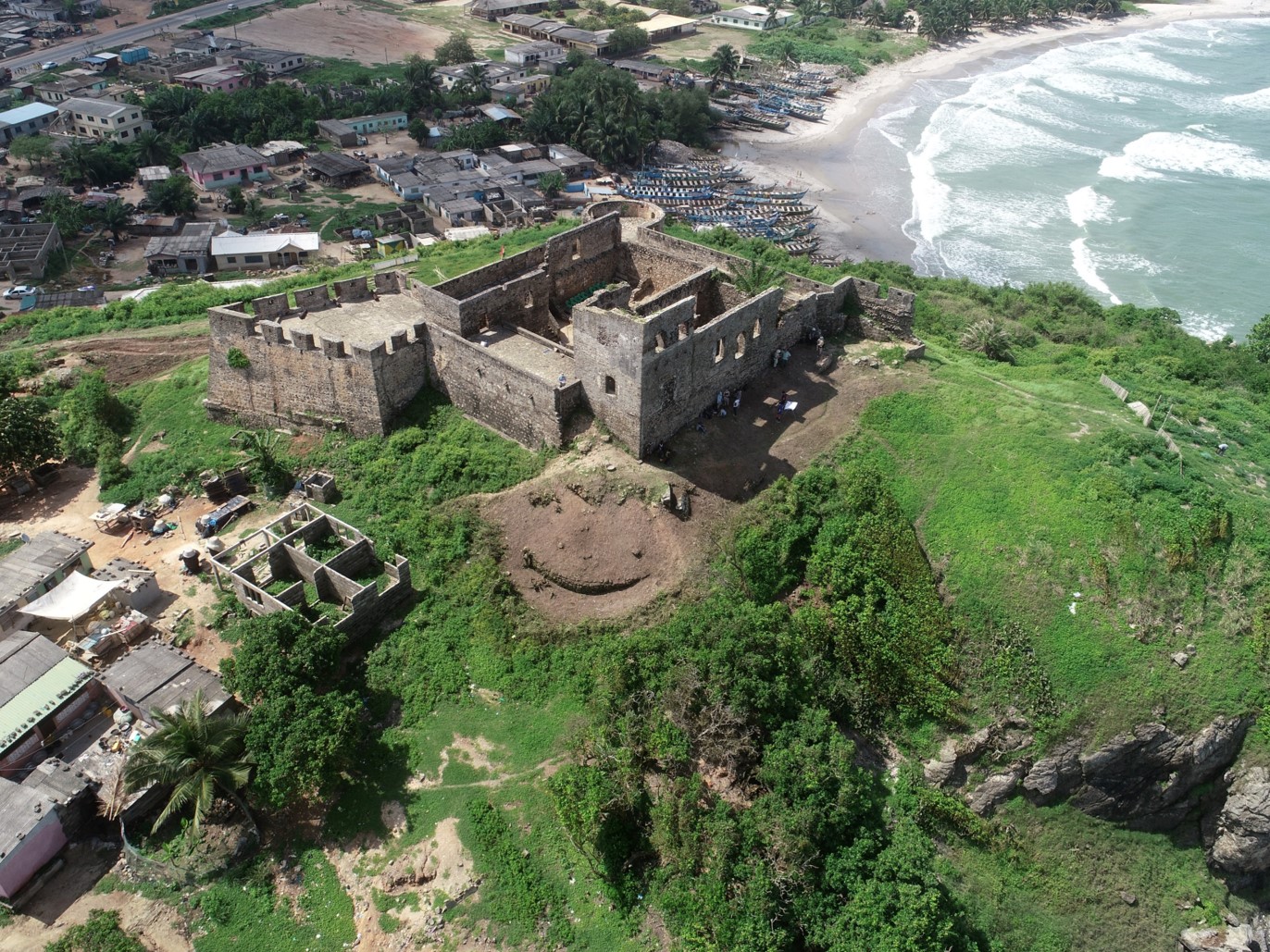Digital Kormantin –
Multidisciplinary Research and Education
As England’s first fort in West Africa and a major gold and slave trading site, Kormantin has enormous historical and cultural significance. The fort’s initial construction and massive rebuilding by the Dutch (Fort Amsterdam) after its 1665 capture introduced new building materials and construction methods into West Africa and reflect a distinct shift in early modern European military architecture. The English and Dutch forts reshaped the community and hinterland regionally, making Abandze an important, populous commercial and coastal shipping center. Kormantin is also an important Black Atlantic and African Diaspora site as the embarkation point for tens of thousands of enslaved Africans bound to mostly Caribbean destinations who formed a “Coromantee” ethnym identity in the Americas. As such, Abandze has become a modern-day pilgrimage site for African Americans whose ancestors passed through here.
Studying and understanding Kormantin’s rich complex history is best achieved through multidisciplinary collaboration. Archaeologists, structural engineers, linguists, anthropologists, art historians, architects, Black Studies scholars, and historians in a host of subfields can all contribute to unearthing and reconstructing Kormantin’s past and making connections with scholars, visitors, and residents today. A more holistic understanding springs from finding and using the widest range of evidence – documents and maps, stories and sketches, photos and remembrances, artifacts and excavations. – and then bringing it all together in dynamic new ways in a digital platform. .
The Digital Kormantin Research Project
Funded by the U.S. National Endowment for the Humanities, the University of Rochester, and Syracuse University, DK is an international multidisciplinary research collaboration launched in 2017. Faculty, staff, and students from UR, SU, the University of Ghana, and the Ghana Museums and Monuments Board (GMMB) have joined together in archival, architectural, and engineering study of Fort Amsterdam and the historical landscape surrounding it using state-of-the-art technologies and research methods. Using laser scanning, drone and ground-based photogrammetry, digital solid modeling, and traditional field recording and archaeological excavation techniques, we have created highly detailed digital models of the site for virtual modern and historical visualization and material conservation purposes. NEH-funded, Syracuse University-led archaeological fieldwork is also revealing aspects of English Cormantine Castle, buried beneath Fort Amsterdam. Concurrent ethnographic fieldwork is also documenting relationships between the historic site, local people, visitors to the castle, and threats to Abandze Village’s traditional artisanal fishing activities, which date back to the English arrival in the 1630s.
Fort Amsterdam, Abandze, Ghana, 2018 by Michael.Jarvis on Sketchfab
Created with 3,000 photographs using Agisoft Metashape, the low resolution model below enables you to explore Fort Amsterdam as captured in 2018. This model is an early prototype for the DK Virtual Tour Portal we have since created and made available through this website. The DK tour places you within the site and lets you explore it in interactive ways at at embodied human scale. We are also working on building an even more fully interactive VR digital experience.
Resurrecting The Past
How do we know what we know about the past?
Different disciplines use different bodies of evidence to interpret past places and people, guided by their research questions. Anthropologist may interview residents and visitors to understand peoples’ connections to, feelings about, and stories associated with an historic site. Historians comb archives for written accounts of creating and using a site, as well as the activities and events that occurred there. Historical architects and engineers examine the fabric of old structures, using construction materials and techniques to infer how, when, and who built them, how they changed over time, and how sound they are in the present. Archaeologists expose and analyze hidden or buried building elements and artifacts recovered in soil layers associated with them in order to reconstruct a wide range of human activities. Maps and historic sketches and photographs aid archaeologists and historians alike in spatially representing sites at particular moments in time. Taken together, these different disciplinary approaches and the insights they produce allow us the fullest understanding possible of, nevertheless, an always incomplete and imperfectly understood past.
Contrary to expectations, the past is always changing. As scholars find or generate new evidence, ask new research questions, and adopt new technologies and approaches, we revise, correct, or expand our knowledge of particular historic sites and the past more broadly. Contemporary social and political change also destabilizes history: social justice, the pursuit of inclusivity, and a democratizing of whose pasts are worthy of study have radically reshaped much Humanities and Social Science research in recent decades and forced complex reconsiderations of historical sites and events that take multiple perspectives and understandings into account as we recognize and try to address silences and omissions in historical and archaeological records (Trouillot 1995).
Kormantin has a complex and elusive past that has proven particularly challenging to recover. Despite its singular role as the headquarters from which England spread outward along Africa’s Atlantic coast Kormantin has virtually disappeared, since the town is now known as Abandze. England’s Kormantin abruptly ceased in 1665 when a Dutch fleet captured it at the start of the Second Anglo-Dutch War. The battle-battered remains of English “Cormantine Castle” vanished into a rebuilt, expanded Fort Amsterdam around 1681. Over the next century and a half, Fort Amsterdam remained a minor trade center but a significant diplomatic post bordering the Fante Nation. After the 1780s, Kormantin’s trade contracted due to Netherlands’ inability to supply goods and the collapse of the Dutch Slave Trade. When the fort was sacked in 1807 by an Asante army, there was little will to rebuild it; a second capture in 1811 finished it off.
Ironically, we know less about nineteenth- and early twentieth-century Kormantin than we do about its ancient heyday, when English and Dutch companies documented the ships, men, and cargoes that came and went and local interaction with coastal neighbors and inland traders. The ruined fort does not appear on maps and early photographers did not deign to visit it. A single sketched 1920s postcard shows the hilltop fort’s shell peaking from the overgrowth.


